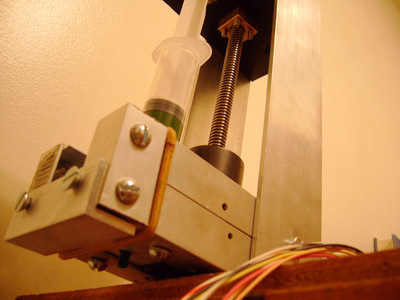The Paint Delivery System
 The paint delivery system was my core first goal in this current approach. I had finally realized I would never complete this project unless I broke everything down into a series of steps and this one in many ways was the most important as it represented the most unique challenge. I had learned already from the previous laser cut screen approach that without an adequate way of controlling the flow of paint onto the canvas, nothing at all could happen.
The paint delivery system was my core first goal in this current approach. I had finally realized I would never complete this project unless I broke everything down into a series of steps and this one in many ways was the most important as it represented the most unique challenge. I had learned already from the previous laser cut screen approach that without an adequate way of controlling the flow of paint onto the canvas, nothing at all could happen.
The key development in creating this painthead was the suggestion from Rob Seward that I try using syringes. I had briefly considered the idea but had rejected it without testing out of concern that the tips of the syringe would clog quickly with paint. But once the idea was revived it became clear that part of the magic of a syringe is that the vacuum action completely eliminates that problem. It also provides a remarkable drip control and an incredible amount of precision in application. I had found an answer to one of the core issues with the paint head. Of course this syringe based design requires manually changing colors, but I can live with that. Details on manually testing out the syringe approach are below.
The second massive challenge was to build a device that could control a syringe via a computer. The approach I took after some research was to use a lever attached to a stepper motor powered lead screw to press down on the syringe. Simple enough in principal but building it out required I learn how to do some basic machining. In this I am eternally grateful to Richard Miller who patiently both taught me the basics and taught me how to love working with metal. And I love working with metal now, it holds an attraction that neither wood nor plastic ever even began to evoke in me. I never thought aluminum would be my favorite material, but...
This painthead is a fully mechanically functioning prototype, with a working stepper motor attached. The electronics are not done yet, but if they somehow work this might become the final painthead. More likely some retooling or reconstruction are in store at a later stage.